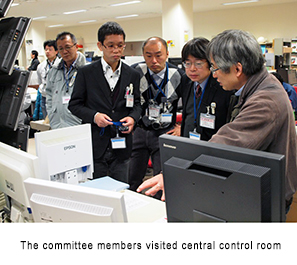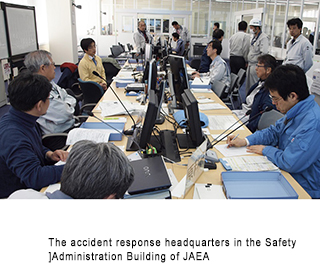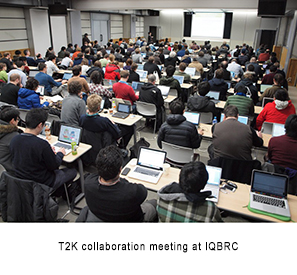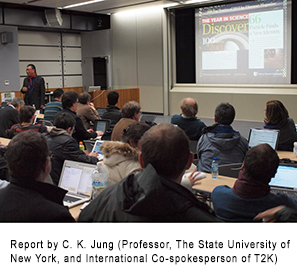| ”@J-PARC News - January 2014 (Issue #105) |
| To prevent a recurrence of a similar radioactive material leak accident at the Hadron Experimental Facility and to endure the safety, the J-PARC center established an international review committee composed of experts, including some from overseas. At the first meeting in October, they discussed the renovation plans of the target system, etc. At the most recent meeting, reports were given on subsequent progress, and a review was carried out of the design and the safety of the Coherent Muon to Electron Transition (COMET) beamline and other equipment that are being planned to be installed hereafter. |
|
| The Second Meeting of Radiation Safety Review Committee (January 15) |
| The discussed topics at the meeting are as follows: (1) the results of the gold target observation; (2) the renovation plans for the Hadron Experimental Facility; and (3) the inspection results of the test equipment for the first stage accelerator that was newly prototyped at the LINAC. In addition, there was discussion of topics such as the draft application for permission to change the experimental facility, and the planned revisions in the local rules to prevent radiation hazards. Prior to the meeting, the participants toured the accelerator control room of the Central Control Building, the primary beamline of the Neutrino Experimental Facility, and other facilities of J-PARC. |
  |
 * Click here to enlarge. * Click here to enlarge. * Click here to enlarge. * Click here to enlarge. |
| £to Page Top |
|
| Emergency Drill Held for a Radiation Accident Scenario at the Neutrino Experimental Facility (January 20) |
| J-PARC is visited every year by many researchers and engineers from overseas, who come for the T2K neutrino experiment and other work. Recently, the emergency drill was carried out at the Neutrino Experimental Facility with the participation of foreign researchers. In the drill scenario, activated helium gas leaked from the helium container holding the target, and this gas arrived at the basement machine room of the Target Station (TS) Building. Seven people who were conducting equipment tuning work in the building were temporarily evacuated outdoors. Emergency response procedures were confirmed, such as shifting from the Alert Status to the Emergency Status, and setting up an on-site response headquarters and an accident site command post. |
  |
 * Click here to enlarge. * Click here to enlarge. * Click here to enlarge. * Click here to enlarge. |
| £to Page Top |
|
| Neutrino Collaboration Meeting (January 20-25) |
| In this meeting at the Ibaraki Quantum Beam Research Center, there was lively discussion of topics relating FY2014 plans for the T2K experiment such as the latest results on neutrino oscillation analyses obtained in the T2K experiment, renovation plans to improve the sensitivity of the neutrino detectors, an increase in LINAC beam energy, and the maintenance of the magnetic horns. In the plenary session on the 23rd, the hall resounded with applause when it was reported that last year's result from the T2K experiment had been chosen as one of the top 100 science stories of 2013 by "Discover magazine" of the USA. |
   |
 * Click here to enlarge. * Click here to enlarge. * Click here to enlarge. * Click here to enlarge. |
| £to Page Top |
|
| The three magnetic horns installed in the Target Station Building of the Neutrino Experimental Facility are special electromagnets for efficiently sending the neutrino beam generated at J-PARC into the neutrino detector, "Super-Kamiokande", located about 300 km away. The magnetic horns have been used for about four years since the first successful beam generation in April 2009, and at present, work is underway to replace these with newly fabricated horns. Replacement of the third magnetic horn was completed at the end of 2013. Replacement of the second and the first horns, and also the target will be done in steps hereafter. |
 
 * Click here to enlarge. * Click here to enlarge. |
| £to Page Top |
|
| Maintenance Work at the Materials and Life Science Experimental Facility |
| Numerous maintenance tasks have been carried out at the Materials and Life Science Experimental Facility during the period that the J-PARC operation has been shut down since last year. The tasks include (1) the inspection, maintenance and renovation of the target mercury circulation system for the neutron generator, (2) the reworking of the beam shutter drivers, and (3) the work using the remote control manipulators of the irradiated components handling room. Maintenance on the newly installed neutron and muon beamlines is also underway in the experimental halls. |
|
| Safety Portal Site Begins Operation (December 25) |
| As part of efforts to foster safety culture, the J-PARC Center has launched the "J-PARC Safety Information" website, which centralizes various types of information relating to safety for J-PARC staff members. The primary aim of the site is the improvement of safety awareness and convenience of staff members. It features a wealth of information including safety related handbooks, safety education materials, emergency response protocols, disaster preparedness information, various procedure forms, and rules. Development of a portal site of safety information for J-PARC users is also being considered. |
|
| SAT Technology Showcase 2014 in Tsukuba (January 24) |
| The purpose of this event was to enhance exchanges among researchers. It was organized by the Science Academy of Tsukuba (SAT) , and held at the Tsukuba International Congress Center. A total of 118 posters are presented there. In the indexing presentation, where contents of each poster were presented in one minute, four presentations from J-PARC were featured, including overviews of neutron and muon experimental instruments, and research results from the T2K experiment. The corporate exhibition corner showcased facilities, research contents and other topics using models, panels and publicity DVDs. Also, in a panel discussion envisioning the future of accelerator science, Dr. Akira Matsumura, Deputy Director of University of Tsukuba Hospital, noted that J-PARC technology was used as the basis of small accelerator development for Boron Neutron Capture Therapy (BNCT) , which was currently being carried out by Ibaraki Prefecture. |
|
Copyright 2011 JAEA and KEK Joint Project. All rights reserved.
|
|